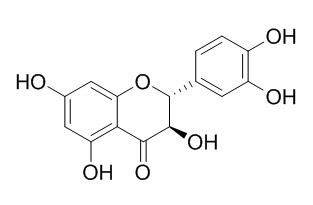(+)-Taxifolin
(+)-Taxifolin is an inhibitor of aggregation of the 42-residue amyloid β-protein, it has preventive effects against Alzheimer's disease-like pathogenesis in vivo. It is also a weak inhibitor of cytochrome b5 reduction (IC50=9.8μM).
Inquire / Order:
manager@chemfaces.com
Technical Inquiries:
service@chemfaces.com
Tel:
+86-27-84237783
Fax:
+86-27-84254680
Address:
1 Building, No. 83, CheCheng Rd., Wuhan Economic and Technological Development Zone, Wuhan, Hubei 430056, PRC
Providing storage is as stated on the product vial and the vial is kept tightly sealed, the product can be stored for up to
24 months(2-8C).
Wherever possible, you should prepare and use solutions on the same day. However, if you need to make up stock solutions in advance, we recommend that you store the solution as aliquots in tightly sealed vials at -20C. Generally, these will be useable for up to two weeks. Before use, and prior to opening the vial we recommend that you allow your product to equilibrate to room temperature for at least 1 hour.
Need more advice on solubility, usage and handling? Please email to: service@chemfaces.com
The packaging of the product may have turned upside down during transportation, resulting in the natural compounds adhering to the neck or cap of the vial. take the vial out of its packaging and gently shake to let the compounds fall to the bottom of the vial. for liquid products, centrifuge at 200-500 RPM to gather the liquid at the bottom of the vial. try to avoid loss or contamination during handling.
Oncology Letters2018, 4690-4696
Planta Medica International2022, 9(01):e108-e115.
Front Immunol.2017, 8:1542
Nutrients.2021, 13(3):978.
Molecular & Cellular Toxicology2017, 13(3):271-278
Herbal Formula Science2024, 32(3):203-221
Sci Rep.2017, 7(1):3249
Environ Toxicol.2019, 34(12):1354-1362
Appl. Sci.2022, 12(17), 8646.
Foods.2023, 12(7):1355.
Related and Featured Products
Toxicology. 2013 Jun 7;308:34-40.
In vitro effects of myricetin, morin, apigenin, (+)-taxifolin, (+)-catechin, (-)-epicatechin, naringenin and naringin on cytochrome b5 reduction by purified NADH-cytochrome b5 reductase.[Pubmed:
23567315 ]
The microsomal NADH-dependent electron transport system consisting of cytochrome b5 reductase and cytochrome b5 participates in a number of physiologically important processes including lipid metabolism as well as is involved in the metabolism of various drug and xenobiotics.
METHODS AND RESULTS:
In the present study, we assessed the inhibitory effects of eight dietary flavonoids representing five distinct chemical classes on cytochrome b5 reduction by purified cytochrome b5 reductase. From the flavonoids tested, myricetin was the most potent in inhibiting cytochrome b5 reduction with an IC50 value of 0.35μM. Myricetin inhibited b5 reductase noncompetitively with a Ki of 0.21μM with respect to cofactor NADH, and exhibited a non-linear relationship indicating non-Michaelis-Menten kinetic binding with respect to cytochrome b5. In contrast to the potent inhibitory activity of myricetin, (+)-Taxifolin was found to be a weak inhibitor (IC50=9.8μM). The remaining flavonoids were inactive within the concentration range tested (1-50μM). Analysis of structure-activity data suggested that simultaneous presence of three OH groups in ring B is a primary structural determinant for a potent enzyme inhibition.
CONCLUSIONS:
Our results suggest that inhibition of the activity of this system by myricetin or myricetin containing diets may influence the metabolism of therapeutic drugs as well as detoxification of xenobiotics.
Biosci Biotechnol Biochem. 2013;77(5):1100-3. Epub 2013 May 7.
Structure-activity relationship for (+)-taxifolin isolated from silymarin as an inhibitor of amyloid β aggregation.[Pubmed:
23649236]
Silymarin, the seed extract of Silybium marianum, has preventive effects against Alzheimer's disease-like pathogenesis in vivo.
METHODS AND RESULTS:
We isolated (+)-Taxifolin (4) from silymarin as an inhibitor of aggregation of the 42-residue amyloid β-protein. Structure-activity relationship studies revealed the 3',4'-dihydroxyl groups to be critical to the anti-aggregative ability, whereas the 7-hydroxyl group and the stereochemistry at positions 2 and 3 were not important.



